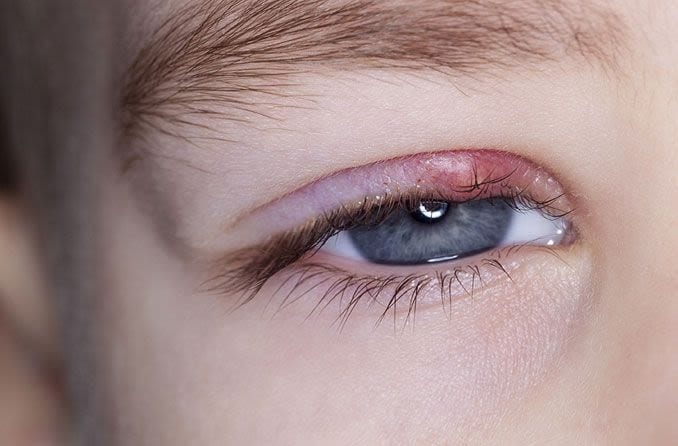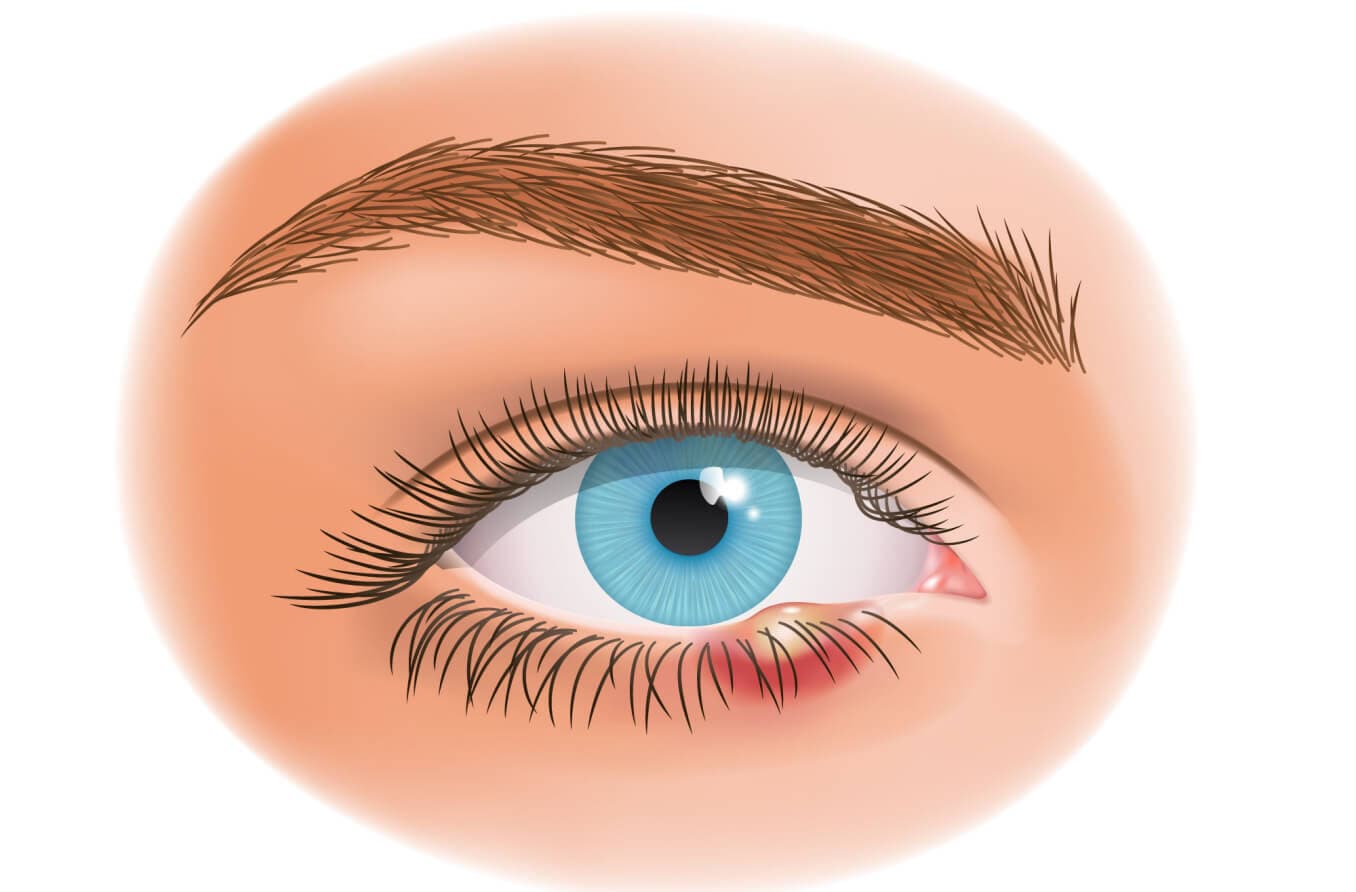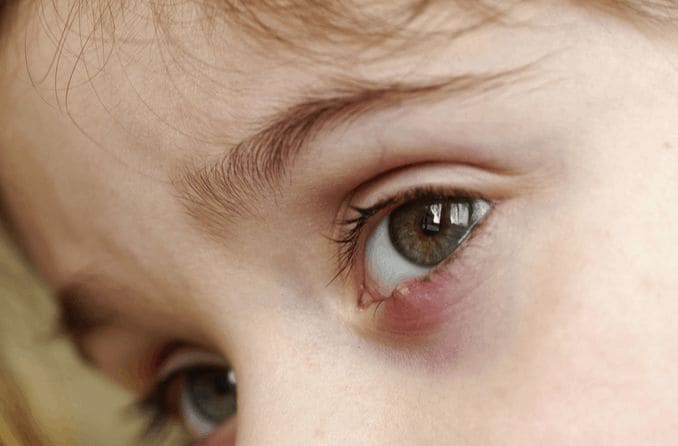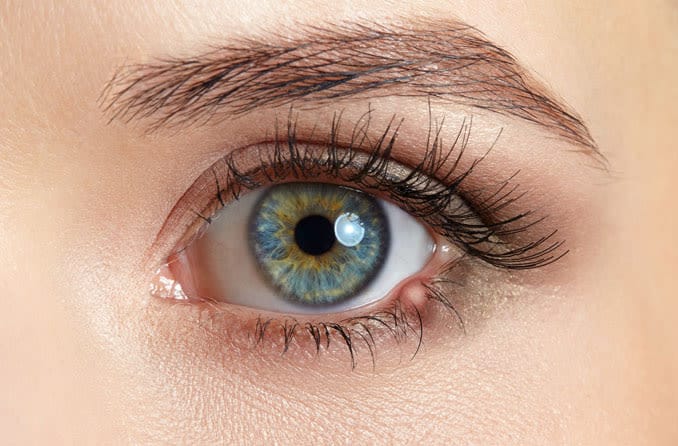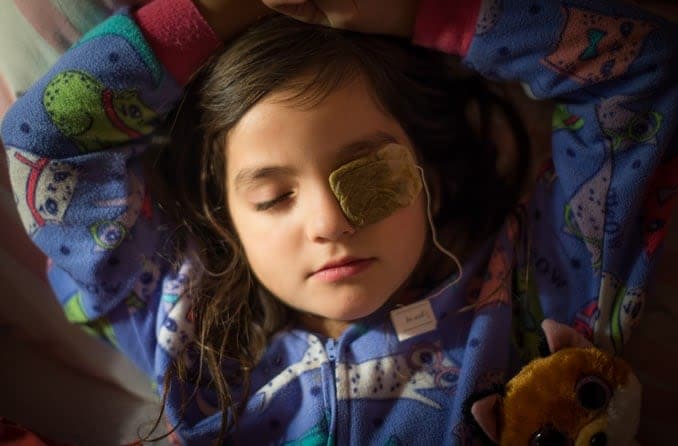Medicine for treating styes
For most styes, eye doctors usually recommend simple home treatments like warm compresses and gentle eyelid cleansers. They may also recommend saline solution or lubricating eye drops to help ease discomfort. Styes that don’t improve with at-home care may be treated with topical or oral antibiotics.
The medical name for a stye is a hordeolum (hor-DEE-uh-lum). Hordeola are a very common type of eyelid infection. They occur when bacteria, usually staph, gets trapped inside a clogged oil gland in the eyelid.
A hordeolum is usually tender or even painful and looks a lot like a pimple with a whitehead. Most will form at the base of an eyelash, but they do sometimes form internally, on the inside of the eyelid. Typically, they form, develop, heal and go away in about a week — sometimes two.
However, hordeola don’t always go away on their own. Stubborn, persistent styes (not to be confused with chalazia) do occur. Some people also experience recurrent hordeola — meaning they keep coming back — or many at once. This can be due to a range of causes, from a weakened immune system to an underlying health or skin condition.
It’s important to see your eye doctor if a hordeolum doesn’t start to get better within a week or if it keeps returning. You should also schedule a visit if you experience more than one stye at a time despite good eyelid hygiene.
SEE RELATED: How to clean your eyelids
Eye doctors will usually prescribe antibiotics in these situations, as well as medication to help with symptoms. They will also be able to determine if an underlying condition may be causing your problem.
Prescription antibiotics
Eye doctors often recommend at-home stye care over prescription antibiotics at first. This is because most cases heal so quickly on their own that antibiotics won’t actually speed up the process. Unnecessary (or improper) antibiotic use can lead to antibiotic resistance. For this reason, many doctors don’t prescribe them for minor infections.
But if a hordeolum doesn’t improve after a few days or keeps coming back, antibiotics might be in order. Depending on the cause and severity of the infection, your eye doctor may prescribe a topical or oral antibiotic or both.
Topical ointments and eye drops
Erythromycin ophthalmic ointment is the most commonly prescribed topical antibiotic for styes. Another common option is bacitracin ophthalmic ointment. Erythromycin is a bacteriostatic drug, which means it prevents the growth of bacteria. Bacitracin is a bactericidal drug, which means it kills bacteria.

Depiction of how to apply erythromycin ointment to the eye
But topical medicines like these can’t actually penetrate the skin to the source of the infection. They won’t be able to make a hordeolum heal any quicker, but they will keep any bacteria on the surface at bay.
This can help keep the infection from spreading or getting any worse. Often, doctors will prescribe antibiotic ointment for a hordeolum that is actively draining. It can also be particularly helpful with styes related to chronic blepharitis or high levels of normal skin bacteria. And, depending on the compound of your prescription, it may help to reduce swelling and inflammation.
Antibiotic eye drops are not commonly used for styes. This is because antibiotics in eye drop form only work against bacteria on the surface of the eyeball. They won’t have much (or any) effect on the outside of the eyelid, where most hordeola are.
However, an antibiotic eye drop like Besivance might be prescribed for an internal hordeolum. Besivance is typically used to treat bacterial conjunctivitis. It is formulated to stay on the eye’s surface longer than other antibiotic eye drops. This prolonged contact means there is a better chance it can be absorbed by the inner eyelid.
Oral antibiotics
Generally, eye doctors only prescribe an oral antibiotic if the infection has spread or if there is a risk that it will spread. If the infection migrates out of the clogged gland, it can become periorbital cellulitis. This is a much more serious type of infection.
They may also prescribe an oral antibiotic if you have a fever with your hordeolum or if it is especially swollen. Surgical drainage is another common treatment for persistent hordeola. Eye doctors will prescribe antibiotics after this procedure to prevent infection while it heals.
Oral antibiotics are the only stye medication that attacks the infection from the inside. However, not all antibiotics are effective or appropriate for this type of infection. The best oral antibiotics for a hordeolum include:
- Tetracycline (doxycycline)
- Cephalosporin (cephalexin)
- Bactrim DS
- Erythromycin
- Amoxicillin
These medications are often used as stye treatment because they are effective in healing skin and soft tissue infections. This includes cellulitis, a potential risk with persistent styes. In addition, they are all effective against staph bacteria — the most common cause of styes.
If you have old antibiotics in your medicine cabinet, don’t use them. A doctor will need to prescribe a specific antibiotic based on what’s best for you and your case. Plus, taking old, leftover antibiotics can make your problem worse in the long run. The bacteria on your body can become resistant, making it even harder to treat future styes.
Steroid injections
Steroid injections are not used to treat a hordeolum. While steroids can help with inflammation, they cannot be injected into an infection.
In severe cases, a doctor may prescribe a steroid after draining a hordeolum with surgery. Once the infection has been drained, a steroid can ease swelling.
Direct steroid injections can be used to treat a large, persistent chalazion. A chalazion is similar to a stye, but it's not an infection. They don't respond to antibiotics and can last much longer than hordeola.
LEARN MORE about other types of eyelid bumps
Steroid injections may cause serious side effects in some people. These side effects can include skin discoloration, tissue atrophy and even vision loss. Be sure to tell your doctor about any reaction you’ve had in the past to steroids when discussing this treatment.
Over-the-counter stye medicines
While most hordeola do resolve quickly with the use of warm compresses, there can still be some discomfort in the meantime. Over-the-counter (OTC) stye medicines are designed to help you feel more comfortable while it heals.
OTC products marketed specifically as stye relief are usually ointments or eye drops. Depending on their ingredients, they may claim to target redness and swelling, itchiness, inflammation, soreness, or dryness and irritation.
However, eye doctors often recommend other OTC eye products — not those marketed as stye relief — to ease symptoms. These include basic eye washes, eyelid scrubs and lubricating eye drops.
No OTC medicines can directly treat a hordeolum or make it heal any faster. But some products, like certain eye washes and eyelid scrubs, have antiseptic properties. They may help to prevent recurring hordeola by reducing surface bacteria.
OTC eye drops and ointments
Like antibiotic eye drops, OTC eye drops work by coating the surface of the eyeball. Since most styes are external (on the outside of the eyelid), eye drops aren’t a good treatment option. But they may help relieve irritation caused by internal hordeola, which are much less common.
Lubricating eye drops and OTC eye washes help keep the eye’s surface clean and hydrated. They also coat the inside of the eyelid, where internal hordeola form.
Eye washes are similar to eye drops, but they're not the same thing. They are also known as irrigating solutions or saline solutions. Eye washes are used in larger quantities than eye drops in order to flood the eye’s surface. This flushes debris and other irritants out of the eye and is much safer than using tap water.
OTC eye washes are primarily just purified water, but they also contain sodium chloride (salt) and, often, boric acid. Saline solutions mimic natural tears, and boric acid acts as a mild antimicrobial.
Using these eye washes as directed may help soothe a painful internal hordeolum. They may also help flush out any bacteria on the surface of the eye or the inside surface of the eyelid.
Examples of OTC eye washes:
Important notes: Don’t confuse eye wash saline solutions with contact lens solutions. Contact lens solutions contain harsher cleaning agents and should never be used to irrigate the eyes. Neither of these products should ever be used as a substitute for rewetting drops.
Lubricating eye drops are also known as artificial tears. The active ingredients in artificial tears work by reducing the evaporation of natural tears. They also create a cushioning film over the eye’s mucous membranes.
Artificial tears are typically recommended to help ease the symptoms of temporary dry eye. But their cushioning properties may protect an internal hordeolum from friction and irritation. They can also help to keep the inside of the eyelid clean and hydrated. This may help an internal hordeolum burst and drain on its own.
Examples of OTC lubricating eye drops:
Stye eye drops that are available over the counter and online claim to relieve symptoms such as inflammation, tearing, redness and burning.
However, it’s important to note that all OTC “stye eye drops” are homeopathic. Products labeled as homeopathic are not reviewed by the FDA for quality, effectiveness or safety. They are not regulated and do not have FDA approval. Always talk to your eye doctor first before using any homeopathic eye product.
Common active ingredients in OTC stye eye drops include conium maculatum (hemlock) extract and various essential oils. Hemlock is a well-known and extremely toxic plant. And general medical recommendations are to keep essential oils away from mucous membranes and the eyes. Often, these drops can cause as much, or more, irritation than the hordeolum.
Examples of OTC stye eye drops:
OTC stye ointments are typically made up of white petroleum and mineral oil. These ointments are essentially the same as products marketed as ointments for dry eye relief.
Like eye drops, they are designed for use inside, rather than outside, of the eyelid. They can create a nice, cushioning barrier between a hordeolum and the surface of the eyeball, which can reduce irritation.
However, there is also potential for these ointments to prolong an internal hordeolum or clog even more glands inside the eyelid. Talk to your eye doctor before using an eye ointment, especially if you have recurring hordeola or meibomian gland dysfunction.
Examples of OTC lubricating and stye ointments:
There are also homeopathic versions of stye ointments available. They claim to relieve symptoms ranging from inflammation to itching and burning. But keep in mind that these products are not regulated in any way for safety or quality. Always talk to your doctor before trying them.
Example of homeopathic stye ointment:
Important note: Never put OTC antibiotic ointments in or near your eyes. Antibiotic ointments and drops that are safe for eyes are only available with a prescription.
OTC eyelid scrubs
Out of all the OTC remedies available, eyelid scrubs and cleansers are the only medicine-like products that may be beneficial for external styes. This is because they are intended for use on the outside of the eyelids. But like other OTC products, they won’t heal or directly treat a stye.
Some OTC eyelid cleansers are designed to remove the daily buildup of dirt and oils or makeup. Many also have ingredients to soothe and moisturize the delicate eyelid skin. Others are designed to disinfect the eyelids and remove surface bacteria or demodex mites.
Eyelid scrubs are often recommended for people who have recurring or frequent hordeola. They are also recommended for those with blepharitis and meibomian gland dysfunction (MGD), eyelid conditions that can lead to styes.
If you’re only dealing with one hordeolum that isn’t related to blepharitis or MGD, basic daily eyelid wipes may be a good choice. They are a gentle, eye-safe method for keeping it clean and hydrated, which may help it burst and heal.
Eyelid scrubs and sprays made with hypochlorous acid (HOCI) are also good options for relieving symptoms. HOCI is an antimicrobial disinfectant that can also soothe inflammation and itchiness. Anyone with a hordeolum can use these products, but they are especially beneficial for preventing future styes due to blepharitis and MGD.
Examples of OTC eyelid wipes, scrubs and sprays:
- Honest Beauty Makeup Remover Wipes
- Bausch + Lomb Biotrue Micellar Eyelid Cleansing Wipes
- OCuSOFT Original Lid Scrub
- TheraTears SteriLid Antimicrobial Eyelid Cleanser and Facial Wash
- Avenova OTC Antimicrobial Spray Solution
Important note: Some HOCI sprays and scrubs do not contain cleansing agents. These products are meant to be used in combination with an eyelid cleanser. Use these products only as directed, and talk with your eye doctor before using them.
Pain medicine
Common over-the-counter pain medicine — such as ibuprofen (Advil and Motrin), naproxen (Aleve) and acetaminophen (Tylenol) — can help relieve any pain or discomfort caused by a stye. Ibuprofen and naproxen are anti-inflammatory drugs, so they may also reduce some of the swelling and redness along the eyelid.
These OTC pain relievers can’t heal a hordeolum or speed it up. But the extra relief they provide could help with tenderness during eyelid cleansing or even while sleeping. Reduced pain and swelling can also help you avoid unconsciously rubbing or touching the hordeolum, which can make it worse.
Because ibuprofen and naproxen can help with swelling, they are good options to help relieve your symptoms. Naproxen typically lasts about twice as long as ibuprofen, but it takes a little longer to “work.” Naproxen can also be harder on the stomach than ibuprofen, and it’s not recommended for children under 12.
Acetaminophen is a better option for those who have stomach issues or who take blood thinners. It won’t help with swelling, since it’s not an anti-inflammatory, but it can still help with pain and tenderness.
Always talk to your doctor or pharmacist before taking OTC drugs or giving them to children. Even OTC medicine can cause drug interactions and unexpected side effects in some people.
When medicine doesn't help
If your hordeolum worsens, affects your vision or doesn’t go away with medicine, it may be time to discuss stye removal surgery with your eye doctor.
A persistent hordeolum that doesn't resolve with treatment can eventually become a chalazion. Further, if a stye gets too severe without being surgically drained, it can turn into periorbital cellulitis.
This is why you should never pop a stye. It can release bacteria and cause the infection to spread into a different part of your eyelid or even deeper into your eye.
If you have persistent trouble with styes, schedule an appointment with your eye doctor. They can talk with you about treatment, prevention and what causes styes to form.
Typically, styes are not contagious. However, it's still a good idea to wash your hands frequently and avoid touching your stye. This will eliminate any possibility of transferring the bacteria to others.


